
|
Sale 72
February 2-5. 2013
| Hunter - Roman Imperial Coinage |
| |
| |
| Lot |
Photo |
Description |
Realized |
Lot 4224 |
 |
Theodosius I, AD 379-395. Silver Medallion of 8 Siliquae (or 3 Light Miliarense) (12.92g) minted at Rome, AD 383-392. D N THEODO-SIVS P F AVG. Pearl-diademed, draped, and cuirassed bust of Theodosius right. Reverse: TRIVMFATOR GENT BARB. Theodosius, in military attire, standing slightly right, head left, holding labarum in crook of right arm, globe in left hand; to left, barbarian captive kneeling; R T in exergue. Gnecchi 7; RIC IX 52a; Toynbee pl. XXXIII, 8 (same obv. die); Cohen 34. Of far better quality than the two examples previously recorded. Gray toning with golden hues around the devices. A spectacular example with an impressive portrait, struck on sound metal. Of the highest rarity. Only the third specimen known. Extremely Fine.
Theodosius I, the Great was the last man to rule the entire Roman Empire and was a formative figure of the medieval era. His father, Theodosius the Elder, was a powerful general in the Roman army under the emperor Valentinian I (AD 364-375) and the younger Theodosius served under him during the critical British campaign of AD 367-368. He won rapid advancement and was made governor of Moesia in AD 375, but a period of disgrace followed the execution of his father for high treason in AD 376. Theodosius retired to his Spanish estates, but the disastrous battle of Adrianople in AD 378, in which the Goths smashed the Roman field army and killed the East Roman Emperor Valens, brought about his recall. Gratian, emperor of the West, appointed Theodosius as co-Augustus in January of AD 379, tasking him with restoring the shattered East Roman army and quelling the Gothic revolt. Years of arduous campaigning forced the Goths into relative submission in AD 382, but the peace treaty settled them in Thrace and allowed them a great deal of autonomy. In January of AD 383, Theodosius proclaimed his six-year-old son Arcadius as co-emperor, but in the same year Gratian was slain and replaced by the usurper Magnus Maximus. Civil war broke out in AD 388, when Maximus invaded Italy and Theodosius moved west to meet and defeat him. Theodosius remained in Italy for three more years to settle affairs and returned to Constantinople in AD 391, but the usurpation of Eugenius brought about another destructive civil war in AD 394. Again, Theodosius won the day and remained supreme over both halves of the Empire until his premature death in January of AD 395. A zealous Catholic, Theodosius had issued numerous edicts against paganism that effectively made Christianity the empire's state religion, leading later church authorities to hail him as "the Great."
This remarkable silver medallion was struck in Rome; comparable medallions have been recorded for Arcadius and Valentinian II, but not for Gratian, suggesting the issue postdates the latter's death in August of AD 383. On the reverse, Theodosius is depicted as "Vanquisher of the Barbarian Peoples," probably alluding to his hard-fought settlement with the Goths in AD 382.
Estimated Value $80,000 - 90,000.
Ex Numismatica Ars Classica 62, lot 2114.
View details and enlarged photos
| Realized
$106,375 |
Lot 4225 |
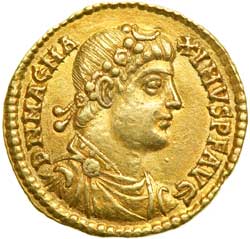 |
Magnus Maximus, AD 383-388. Gold Solidus (4.59g) minted at Londonium-Augusta (London), AD 384. Rosette-diademed, draped and cuirassed bust of Maximus right. Reverse: Maximus and Theodosius enthroned facing, holding a globe between them; behind and between them, Victoria (Victory) facing with outspread wings; below throne, palm frond; AVGOB in exergue. RIC 2; Depeyrot 2/1; Cohen 9. Extremely rare. Extremely Fine.
First conquered by Claudius in 43 BC, Britain had been a province of the Roman Empire for three and a half centuries when the Spanish general Magnus Maximus was made governor in AD 380. An ambitious aristocrat with familial ties to the eastern Roman emperor Theodosius I, Maximus soon decided to make a bid for the throne of the western Roman Empire, then ruled by a bookish youth named Gratian. To secure the loyalty of the British Roman legions, Maximus reopened the old mint of London, which had been closed for more than 50 years, and began striking gold solidi acclaiming himself as Augustus, or emperor. By this time, London had been renamed Augusta, as reflected by the mint mark on the reverse of this piece (AVG OB, the "OB" standing for "obryzium," or "pure gold"). With his army thus paid off, Maximus crossed into Gaul and easily defeated Gratian. In retrospect, his move was ill-advised, as it deprived Britain of soldiers it needed badly to defend the frontiers from barbarian attack, as well as contributing to the instability which ultimately caused the collapse of the western Roman government. Within 20 years, Roman rule had come to an end in Britain.
The gold solidi of Magnus Maximus were thus the last coins struck in Roman Britain.
Estimated Value $15,000 - 18,000.
Ex Goldberg Coins, Auction 53, May 26, 2009, lot 1933; L. Biaggi Collection, # 2312.
View details and enlarged photos
| Realized
$17,250 |
Lot 4226 |
 |
Magnus Maximus, AD 383-388. Gold Aureus (4.6g) minted at Londoninium-Augusta (London), AD 384. DN MAG MA-XIMVS PF AVG. Diademed, draped and cuirassed bust of Magnus, right. Reverse: VICTOR-IA AVGG. Magnus Maximus and Theodosius enthroned facing, holding globe between them; Victoria (Victory) above; palm branch below; AVG OB in exergue. Cohen 9; RIC 2(B). Some minor marks about the obverse rims. Extremely rare. Fewer than ten specimens recorded and of great historical importance. Some minor marks about the obverse rims. Nearly Extremely Fine.
Estimated Value $12,500 - 15,000.
Ex Numismatica Ars Classica 62, lot 2115; Bonhams/Vecchi Sale No. 8, Oct. 12-13, 1982, lot 709; Levis Collection - Naville auction XI,- June 18-20, 1925, lot 1032.
View details and enlarged photos
| Unsold |
Lot 4227 |
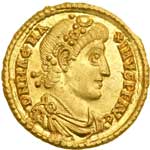 |
Magnus Maximus, AD 383-388. Gold Solidus (4.4g) minted at Treveri, AD 385-386. D N MAG MA - XIMVS P F AVG. Rosette-diademed, draped and cuirassed bust right of Magnus Maximus. Reverse: VICTOR - IA AVGG. Two emperors seated facing on throne, together holding globe; emperor to right holds mappa in his left hand; behind throne, between heads, Victoria (Victory) facing, wings outspread; below, palm branch; in exergue, TROB. RIC 77(b); Depeyrot 52/1. Well struck with underlying luster. Very scarce. Superb Extremely Fine.
One of the more colorful characters of late Antiquity, Magnus Maximus was proclaimed Augustus by his soldiers in Britain who were dissatisfied with the rule of the youthful emperor Gratian (AD 367-383). Maximus had been appointed commander-in-chief (comes) in Britain because of his intimate knowledge of the province where he had previously served under Count Theodosius. He immediately crossed to Gaul and advanced to meet Gratian in battle, but the latter was deserted by his own troops in a situation somewhat reminiscent of the downfall of Constans thirty-three years before. After Gratian's execution, Maximus was left in control of most of the Western Empire, though the late emperor's younger brother Valentinian II was still recognized in Italy. The eastern emperor Theodosius reluctantly accepted this coup d'état though he had his own dynastic ambitions, and a trial of strength between East and West appeared to be inevitable. Matters came to a head in AD 387 when Maximus invaded Italy, forcing Valentinian to seek refuge in Constantinople. This provided Theodosius with the perfect pretext for launching his own invasion of Maximus' territory and the Western emperor was decisively defeated in two battles resulting in his execution. This exceptionally well-preserved gold solidus was issued at Maximus' main mint of Treveri.
Estimated Value $6,000 - 8,000.
The Hunter Collection.
View details and enlarged photos
| Realized
$13,800 |
Lot 4228 |
 |
Honorius, AD 393-423. Gold Solidus (4.44g) minted at Constantinople, AD 403-408. Pearl-diademed, helmeted and cuirassed bust of Honorius facing three quarters right holding spear and shield adorned with horseman. Reverse: Constantinopolis seated facing, head right, foot on prow, holding scepter and Victoria (Victory) on globe; legend ends, H. RIC Vol. X, 30; Depeyrot 57/2. Sharp and lustrous. Superb Extremely Fine.
Estimated Value $1,000 - 1,400.
Wolfen Family Foundation, purchased from Bank Leu early 1970s.
View details and enlarged photos
| Realized
$805 |
Lot 4229 |
 |
Theodosius II, AD 402-450. Gold Solidus (4.46g) minted at Constantinople, AD 422/3. Helmeted, diademed and cuirassed bust of Theodosius II facing three quarters right, holding spear and shield. Reverse: Victoria (Victory) standing left, holding a long jeweled cross; legend ends: θ. RIC 219; Depeyrot 74/2. Well detailed with full legends. Superb Extremely Fine.
Estimated Value $1,000 - 1,400.
Ex Wolfen Family Foundation, purchased from Bank Leu early 1970s.
View details and enlarged photos
| Realized
$2,300 |
Lot 4230 |
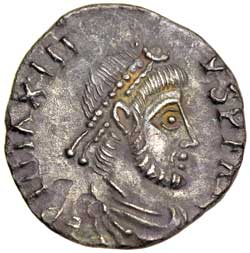 |
Maximus, AD 409-411. Silver Siliqua (1.1g). Minted at Barcino (Barcelona), AD 410-411. Usurper in Spain. D N MAXIM-VS P F AVG. Diademed, draped and cuirassed bust of Maximus, right. Reverse: [VICTOR]AA [sic] AVGGG. Roma seated left on cuirass, holding Victoria (Victory) on globe in right hand and reversed spear in left; [S]MBA in exergue. RIC X 1601; RSC 1b; Cohen 1. Exceptionally detailed portrait for this normally crude issue including a clear obverse legend. Dark "hoard patina" intact. Exceedingly rare. Probably the finest known specimen. Extremely Fine.
The brief usurpation of "Maximus of Barcelona," as he came to be known, occurred during the virtual disintegration of the West Roman Empire during the reign of Honorius, AD 393-423. The massive barbarian invasion of AD 406 virtually cut Italy off from Gaul, Spain and Britain, resulting in the local Roman garrisons proclaiming their own commanders as emperor. First of these usurpers was Constantine III in Britain, who crossed into Gaul in AD 407 and sent his son Constans II and the half-German general Gerontius into Spain to secure control of the province for his rebel regime in AD 408. Their success was short-lived, however, as invasions by the Vandals and other Germans in AD 409 threw the region into chaos. Constans II fled back to join his father in Gaul; Gerontius, however, remained in Spain and decided to appoint his own puppet emperor. His choice settled on a certain Maximus, who may have been his son, nephew or some other relation, or perhaps merely a senior household officer in his employ. In any case, Maximus duly donned the purple in Barcino (Barcelona), which became his capital, and received the support of several barbarian chieftains. He thus became one of five men claiming the title Emperor of the West in AD 410: Honorius (the only "legitimate" ruler), Priscus Attalus, Constantine III, Constans II, and Maximus. The situation was unstable in the extreme and became more so in AD 411, when Honorius sent the general Constantius into Gaul and Spain with a powerful army to put down the various insurrections. Defeated and cornered, Gerontius committed suicide, depriving Maximus of his principal backer. Rather than fall on his sword, Maximus fled to his barbarian allies, who seem to have protected him for a number of years. In AD 420, he apparently attempted a return to power in Spain, but was soon captured, taken to Ravenna, and executed by Honorius in AD 422.
The coinage of Maximus is confined to reduced silver siliquae struck at a newly created mint in Barcelona, identified with the mintmark SMB. Rather unusually for this period, he is shown with a close-cropped beard, which had in the past hinted at pagan sympathies, but in this case probably only indicated pretensions to scholarship. Philip Grierson knew of only 20 genuine specimens in the early 1990s; a few more seem to have been discovered since then. Fewer than 30 coins of Maximus are known to have survived, of which this example is probably the finest to exist.
Estimated Value $10,000 - 12,500.
Ex Numismatica Ars Classica 62, lot 2120; Classical Numismatic Group 75, May 23, 2007, lot 1152.
View details and enlarged photos
| Realized
$12,650 |
Lot 4231 |
 |
Priscus Attalus, AD 409-410. Gold Solidus (4.47g) minted at Rome, September-December AD 409. IMP PRISCVS AT-TALVS P F AVG. Pearl and rosette-diademed, draped and cuirassed bust of Attalus right. Reverse: VICTORIA AVGVSTI R - M. Attalus standing right in military attire, holding vexillum in right hand and Victoria (Victory) on globe in left; left foot on bound captive; COMOB in exergue. RIC 1401 (R5); Cohen 9. Well struck on a full, round flan. Extremely rare. Certainly the finest example in private hands. Lustrous. Extremely Fine.
Priscus Attalus was born ca. AD 370 to a distinguished family of Ionian Greek extraction and entered the Roman Senate early in the fifth century AD. Although he was a pagan in Christian Rome, Attalus quickly became a prominent senator and spokesman for the aristocracy. Early in AD 409, the Emperor Honorius appointed him Urban Prefect, just as the Visigoths, under their charismatic king Alaric, were rampaging unchecked through Italy. By mid year, Alaric was outside the walls of Rome, demanding enormous concessions in land and gold from the West Roman government and his own appointment as commander-in-chief (magister militum). Honorius, who had taken refuge in Ravenna far to the north, refused negotiations, leaving the denizens of Rome to face slow starvation or slaughter. Outraged by Honorius' abandonment, the Senate elected Priscus Attalus as emperor with instructions to come to terms with Alaric. Attalus readily acquiesced to most of Alaric's demands and joined him in marching on Ravenna early in AD 410 to force further concessions from Honorius. At the same time, Attalus sent a small force to Africa to secure Rome's main granary. The African expedition met with defeat, prompting Honorius to again refuse talks. Attalus' popular support quickly crumbled as it became apparent he was Alaric's puppet. Attalus' decision to accept baptism as a Christian from an Arian Gothic bishop proved a further liability. With Attalus now more burden than benefit, Alaric abruptly deposed him in July of AD 410 and subjected Rome to a thorough sacking the following month. Having alienated the Romans, Attalus became a rootless camp follower of the Visigoths in their wanderings through Italy and Gaul. In AD 414, he enjoyed a brief echo of glory when Alaric's successor Athaulf again proclaimed him emperor in opposition to Honorius. This time, his brief "reign" ended in his capture by loyalist forces. He was marched in chains through the streets of Rome, ritually mutilated by the amputation of his thumb and forefinger, as a symbolic gesture against any future revolt. Then, surprisingly, he was allowed to retire to the island of Lipari, where he eventually died.
Gold solidi of Priscus Attalus rank among the greatest rarities of the Roman series. Struck at Rome following Attalus' elevation, it is of unusually fine workmanship for the period, with a remarkably realistic portrait depicting Attalus with a heavy double chin and a docile, upward-looking gaze. This piece is the finest of perhaps three specimens in private hands.
Estimated Value $200,000 - 250,000.
Ex Numismatica Ars Classica 62, lot 2121; NAC 42, 2007, Feirstein part 2, lot 236; NAC 18, 2000, lot 773.
View details and enlarged photos
| Unsold |
Lot 4232 |
 |
Jovinus, AD 411-413. Silver Siliqua (1.72g) minted at Arles. Usurper in Gaul. D N IOVIN-VS P F AVG. Pearl-diademed, draped and cuirassed bust of Jovinus right. Reverse: RESTIT-[VT]OR REIP. Roma seated left on throne, holding Victoria (Victory) on globe in right hand and reversed spear in left; KONT in exergue. RIC 172; Cohen 2. Unusually crisp, detailed strike. Toned. Very rare. Extremely Fine.
Little is known about the origins of Jovinus, but he was reputedly a highly regarded Gallo-Roman nobleman. During the anarchic period of AD 406-411, when the western Roman Empire essentially disintegrated under repeated barbarian invasions and local insurrections, Jovinus gained the support of several Germanic tribes near the city of Mainz as an alternative to the distant and feeble regime of Honorius. In AD 411, he was proclaimed emperor at Mainz by the Alan king Goar and the Burgundian king Gundahar. Soon afterward he won the support of Athaulf, king of the Visigoths, and for a time it seemed Jovinus had secured control of all Gaul and Roman Germany. The Gallic nobility supported him and coins were struck in his name at Trier, Lugdunum and Arles. However, Jovinus made a serious mistake in obtaining the backing of another powerful Visigoth, Sarus, who was a blood-enemy of Athaulf. In AD 412, Jovinus appointed his brother Sebastianus as co-emperor, which further alienated Athaulf and caused him to open secret negotiations with Honorius. In AD 413 Athaulf openly switched sides and allied himself with the Ravenna regime. Sebastianus was swiftly captured and executed. Jovinus took refuge in the city of Valentia but surrendered after a brief siege. Although he had apparently been promised a fair hearing, Jovinus was summarily executed en route to Ravenna and his head sent on to Honorius.
The coinage of Jovinus is in many ways superior to issues of the "legitimate" Roman regime of Honorius. This rare silver siliqua of the Arles mint bears a finely engraved portrait and the weight is slightly heavier than contemporary Italian issues. The reverse inscription, which translates as "Restorer of the Republic," is a remarkable throwback to an earlier, happier age.
Estimated Value $7,000 - 8,000.
Ex Numismatica Ars Classica 62, lot 2122.
View details and enlarged photos
| Realized
$8,625 |
Lot 4233 |
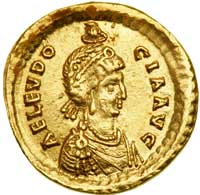 |
Aelia Eudocia, wife of Theodosius II. Gold Solidus (4.3g) minted at Constantinople, AD 423-425. AEL EVDO - CIA AVG. Pearl-diademed and draped bust right of Eudocia, crowned by the hand of god, wearing earring and pearl necklace. Reverse: VOT XX MVLT XXX Δ. Victoria (Victory) standing right, supporting long cross with right hand, holding fold of drapery over left; to inner left, star; in exergue, CONOB. Depeyrot 75/2; RIC 228. Minor obverse earthen deposits. Extremely Fine.
Estimated Value $2,500 - 3,000.
The Hunter Collection.
View details and enlarged photos
| Realized
$4,255 |
Lot 4234 |
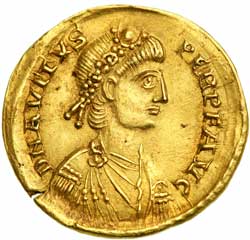 |
Avitus, AD 455-456. Gold Solidus (4.47g) minted at Arles July 9, AD 455 - October 17, AD 456. West Roman Empire. D N AVITVS PERP F AVG. Rosette-diademed, draped, and cuirassed bust of Avitus right. Reverse: VICTORI-A AVGGG. Emperor in military attire standing right, holding long cross in right hand and Victoria (Victory) on globe in left, resting left foot on recumbent captive; A-R in field; COMOB in exergue. RIC 2401; Lacam pl. 9, 16 (this coin); Depeyrot 24/1. Some faint signs of burnishing in the right obverse field. Portrait of unusually fine style and well struck. Exceedingly rare. Nearly Extremely Fine.
The brief, troubled reign of Marcus Maecilius Flavius Eparchius Avitus came against a backdrop of chaos, disintegration and intrigue in the dying West Roman Empire. Avitus was a Romano-Gallic nobleman of high standing who served as an envoy between the Roman Senate and the Visigoths who now ruled large swaths of Gaul and Spain. Upon the death of the usurper Petronius Maximus at Rome in AD 455, Avitus easily gained the support of the Visigothic king, Theodoric II, and was proclaimed emperor of the West at Arles in southern Gaul on July 9 or 10. An assembly of Gallo-Roman nobles ratified the elevation at Toulouse the following month, and the East Roman Emperor Marcian gave his approval in September. The aristocrats and common folk of Italy, however, viewed Avitus as a Gallic interloper and gave him a cool reception upon his arrival at Ravenna. Badly in need of military prestige, Avitus looked about for a capable general to lead his armies and found one in the Romanized barbarian Ricimer, who had won a naval battle against the Vandals off the coast of Corsica early in AD 456. But Ricimer had grand designs of his own. Appointed Master of Soldiers, he soon began intriguing with Majorian, the dashing Roman officer leading the army of Italy, to undermine Avitus' feeble regime. A severe famine in Italy only worsened the position of Avitus, whose Visigothic allies were now preoccupied with a war against the Suevi in Spain. Under pressure from the Italian bluebloods, Avitus dismissed his Gothic bodyguards and Gallic advisors, which only left him more vulnerable. The final coup d'etat came on October 17, AD 456, when Majorian and Ricimer withdrew their support and simply declared Avitus deposed. He fled Rome, hoping to make safe haven in Gaul, but was overtaken by Ricimer, forced to abdicate, and consecrated bishop of Piacenza (a common means of permanently removing someone from government service). He never lived to take up his clerical post, dying a few days or weeks later, either of natural causes or on Ricimer's orders.
The exceedingly rare coinage of Avitus reflects his Gallic origins, as most of the coins in his name appear to have been struck at the newly reopened mint of Arelate (modern Arles), where he was first acclaimed emperor. Most of his coins are hastily and crudely engraved, but this piece is of remarkable style and has a portrait that may truly reflect his brooding, downcast countenance.
Estimated Value $50,000 - 75,000.
Ex Numismatica Ars Classica 62, lot 2126; Cuvreau-Parsy Auction, April 15, 2008, lot 166; Hess-Leu 22, 1963 lot 292.
View details and enlarged photos
| Realized
$115,000 |
Lot 4235 |
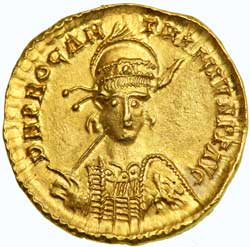 |
Anthemius, AD 467-472. Gold Solidus (4.39g) minted at Ravenna. West Roman Empire. D N PROC AN-THEMIVS P F AV. Helmeted, pearl-diademed and cuirassed bust of Anthemius facing, holding spear over right shoulder and shield bearing horseman and enemy motif on left shoulder. Reverse: SALVS REI-P-V-BLICAE. Two emperors (Anthemius and Leo) standing facing one another, nimbate, each holding globe in left hand, supporting between them with their right hands a long cross; R-V in inner field; COMOB in exergue. RIC 2868; Depeyrot 28/1; Biaggi 2374 (this coin). In exceptional condition. Exceedingly rare. Superb Extremely Fine.
The short, troubled reign of Procopius Anthemius represents the Roman world's last chance at unity in the face of the disasters that would shortly overwhelm its western half. Born into a distinguished and wealthy Constantinopolitan family, Anthemius was highly regarded as a general and magistrate, and had been considered a prime candidate for the East Roman throne when his father-in-law, the emperor Marcian, died in AD 457. Instead, Leo I got the job, but Anthemius took the setback in stride and won a series of military victories over the Goths and Huns on Leo's behalf. In the mid AD 460s, Vandal raids on Greece convinced Leo that he needed to cooperate with the West Roman regime headed by the half-barbarian generalissimo Ricimer. In AD 467, with Ricimer's approval, Leo appointed Anthemius to the vacant western throne. Anthemius reached Rome on 12 April and was duly hailed as Augustus by the Senate, but many Romans viewed him as a Greek interloper and this colored his relations with the locals from the outset. In AD 468, a massive joint naval expedition against the Vandals in North Africa failed, badly undermining Anthemius ' position. Visigothic gains in Gaul further eroded his popularity over the next few years and caused a dangerous rift to develop between Anthemius, who ruled from Rome, and Ricimer, based in Milan. Leo tried to mediate by sending a highborn envoy named Olybrius to the West in the spring of AD 472, but Ricimer decided Olybrius would prove a more pliable puppet emperor and marched against Rome to depose Anthemius. Rome underwent a three-month siege and finally fell to a determined attack on the Pons Aelius. Anthemius donned the garb of a beggar and tried to escape, but was identified, captured and beheaded, probably on 11 July AD 472. Olybrius replaced him but survived only a few months before dying of dropsy. The brief, disastrous civil war made a final split with the East inevitable and sealed the doom of West Roman Empire.
The gold coinage of Anthemius reflects his origins by following the convention for frontal portraiture found on East Roman and later Byzantine coins. The reverse of this Ravenna-mint gold solidus celebrates the supposed unity of East and West empires by showing Anthemius and Leo together supporting a long cross, on which rests, according to the legend, the "Health of the Republic."
Estimated Value $18,000 - 20,000.
Ex Numismatic Ars Classica 62, lot 2130; NAC sale 38, 2007, lot 302 The Biaggi Collection.
View details and enlarged photos
| Realized
$27,600 |
Lot 4236 |
 |
Basiliscus, AD 475-476. Gold Solidus (4.4g) minted at Constantinople. D N bASILIS - CUS P P AVG. Helmeted, pearl-diademed and cuirassed bust facing of Basiliscus holding spear over right shoulder; shield on left arm adorned with horseman riding down enemy. Reverse: VICTORI - A AVGGG. Victory standing left, supporting long, jeweled cross with right hand; to right, star; in exergue, CONOB. RIC 1003; Depeyrot 101/1. Well struck with full legends and unsually well centered. Rare, particularly so in this choice condition. Lustrous. Superb Extremely Fine.
Estimated Value $2,500 - 3,000.
The Hunter Collection.
View details and enlarged photos
| Realized
$3,680 |
|
|